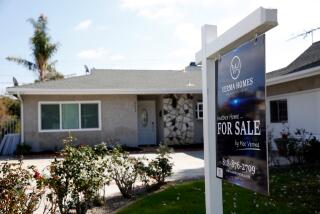New Home Sales Fall 9% to Worst Pace Since ‘82; Factory Orders Off 0.6%
- Share via
WASHINGTON — New home sales fell 9% in January, pushing sales activity to its slowest pace since the end of the last recession, the government said Wednesday as the housing industry continued to stagger following the October stock market collapse.
A downturn in housing has often been the harbinger of the onset of a recession, but analysts said they believed that falling mortgage rates offered the hope of a rebound in home sales in coming months.
In January, the Commerce Department said, sales of new single-family homes fell for the third consecutive month, dropping to a seasonally adjusted annual rate of 535,000 units, 26% below a year ago and the slowest pace since the last recession was ending in December, 1982.
In a second lackluster economic report, the Commerce Department said orders for manufactured goods fell 0.6% in January to a seasonally adjusted $212.6 billion.
While this was the first decline in five months, analysts noted that it followed an unusually large 2% increase in December, a gain that reflected a big jump in demand for jet airplanes.
Analysts said the one-month setback did nothing to change their view that American manufacturers are continuing to enjoy a sales boom led by increased demand for exports.
Analysts said they were surprised by the sharpness of the decline in home sales, especially since sales had already fallen by 6.8% in December and 3.4% in November.
The decline in new home sales followed other reports showing a big decline in construction starts for new homes in January and the third consecutive monthly decrease in sales of existing homes.
“It looks like housing is bearing the brunt of the stock market decline, but I believe lower interest rates can solve a lot of problems in this industry,” said Robert Villanueva, director of economic forecasting for the National Assn. of Home Builders.
Analysts noted that fixed-rate mortgages have fallen into the single-digit range again, averaging 9.87% last week, compared to 10.6% when the year began.
“Essentially the market is driven by what’s happening in mortgage rates,” Villanueva said. “We would anticipate that there would be some recovery in the spring.”
James Christian, chief economist for the U.S. League of Savings Institutions, said that with “mortgage rates moving in the right direction” sales for all of 1988 should rebound to about 650,000 units, only 3% below the 1987 sales pace.
But other analysts said it remained to be seen whether the drop in mortgage rates will be enough to attract new buyers. They noted that sales have been strong for the past three years and a lot of pent-up demand has been exhausted.
“We simply don’t have the demand for housing that we had in the first part of the recovery,” said Michael Sumichrast, an economist and publisher of a construction industry newsletter. “The South, which accounts for almost half of all new homes sold, is still weak and you won’t see any significant improvement until that area turns around.”
Analysts, however, said they were not ready to forecast an end to the current economic recovery.
“We are seeing a shift away from economic growth driven by housing and other domestic sectors and toward growth in manufacturing and other export sectors,” said Warren Lasko, executive director of the Mortgage Bankers Assn.
The 9% decline in new home sales in January was the steepest decline since a 10.9% drop last May. The big decline in sales was accompanied by a sharp rise in prices.
The median, or mid-point, price of a home shot up 9.7% to $120,000 while the average home price rose to $149,000, an increase of 10.5%.
Economists said that while home prices have been outpacing rises in overall inflation in recent months, the January surge was skewed upward by the fact that sales rose in the Northeast, a high-priced section of the country, while they were down sharply in the less-expensive South.
Sales edged up 0.6% in the West to an annual rate of 179,000 units.
Sales dropped 24.4% in the South to an annual rate of 177,000 units. Sales were off 13.7% in the Midwest to a rate of 88,000 units.
Sales rose 23% in the Northeast to an annual rate of 91,000 units, but this big increase followed a much larger 53% decline in December.
Orders for durable goods--items designed to last at least three years, such as refrigerators and washing machines--fell 1.5% in January after rising by 4.2% in December, the department said. In an earlier report it said they had fallen by a steeper 2.8% in January.
Orders for nondefense capital goods rose 2.6% in January to $34.75 billion after a 12.6% surge in December.
“One of the most encouraging things is the increase of 2.6% for nondefense capital goods,” said economist Bill MacReynolds of the U.S. Chamber of Commerce. “It reflects what the private sector is doing and that’s a good indication of continued steady improvement in the economy.”
Weak points in factory orders were in transportation equipment, which fell 8.8% in January after rising by 8.9% in December, and primary metals, which dropped 15.0% after a 10.0% rise in December.
Orders for machinery rose in January and orders for nondurable goods rose 0.5% to $98.71 billion after falling 0.5% in December.
Overall factory order backlogs, meanwhile, rose 1.2% in January to $408.38 billion after a 0.6% December rise, the department said.
Economists said the increase in unfilled orders reflects a fairly low level of inventories in manufacturers’s hands. Although business inventories have been rising in recent months, most are at the retail level, they said.
More to Read
Inside the business of entertainment
The Wide Shot brings you news, analysis and insights on everything from streaming wars to production — and what it all means for the future.
You may occasionally receive promotional content from the Los Angeles Times.










